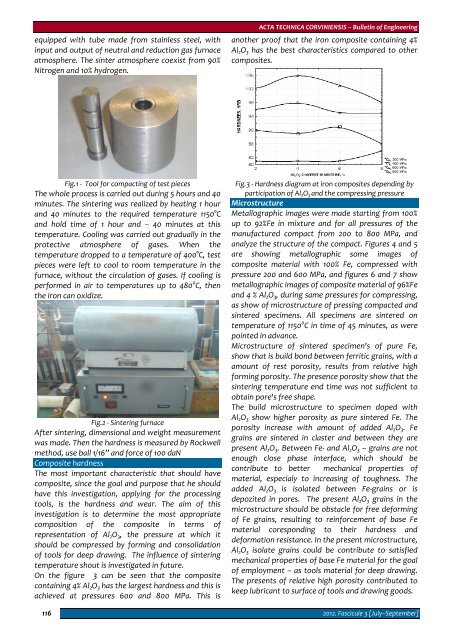1 - Acta Technica Corviniensis
1 - Acta Technica Corviniensis
1 - Acta Technica Corviniensis
Create successful ePaper yourself
Turn your PDF publications into a flip-book with our unique Google optimized e-Paper software.
equipped with tube made from stainless steel, withinput and output of neutral and reduction gas furnaceatmosphere. The sinter atmosphere coexist from 90%Nitrogen and 10% hydrogen.ACTA TECHNICA CORVINIENSIS – Bulletin of Engineeringanother proof that the iron composite containing 4%Al 2 O 3 has the best characteristics compared to othercomposites.Fig.1 ‐ Tool for compacting of test piecesThe whole process is carried out during 5 hours and 40minutes. The sintering was realized by heating 1 hourand 40 minutes to the required temperature 1150°Cand hold time of 1 hour and 40 minutes at thistemperature. Cooling was carried out gradually in theprotective atmosphere of gases. When thetemperature dropped to a temperature of 400°C, testpieces were left to cool to room temperature in thefurnace, without the circulation of gases. If cooling isperformed in air to temperatures up to 480 0 C, thenthe iron can oxidize.Fig.2 ‐ Sintering furnaceAfter sintering, dimensional and weight measurementwas made. Then the hardness is measured by Rockwellmethod, use ball 1/16’’ and force of 100 daNComposite hardnessThe most important characteristic that should havecomposite, since the goal and purpose that he shouldhave this investigation, applying for the processingtools, is the hardness and wear. The aim of thisinvestigation is to determine the most appropriatecomposition of the composite in terms ofrepresentation of Al 2 O 3 , the pressure at which itshould be compressed by forming and consolidationof tools for deep drawing. The influence of sinteringtemperature shout is investigated in future.On the figure 3 can be seen that the compositecontaining 4% Al 2 O 3 has the largest hardness and this isachieved at pressures 600 and 800 MPa. This is116Fig.3 ‐ Hardness diagram at iron composites depending byparticipation of Al 2 O 3 and the compressing pressureMicrostructureMetallographic images were made starting from 100%up to 92%Fe in mixture and for all pressures of themanufactured compact from 200 to 800 MPa, andanalyze the structure of the compact. Figures 4 and 5are showing metallographic some images ofcomposite material with 100% Fe, compressed withpressure 200 and 600 MPa, and figures 6 and 7 showmetallographic images of composite material of 96%Feand 4 % Al 2 O 3 , during same pressures for compressing,as show of microstructure of pressing compacted andsintered specimens. All specimens are sintered ontemperature of 1150 0 C in time of 45 minutes, as werepointed in advance.Microstructure of sintered specimen's of pure Fe,show that is build bond between ferritic grains, with aamount of rest porosity, results from relative highforming porosity. The presence porosity show that thesintering temperature end time was not sufficient toobtain pore's free shape.The build microstructure to specimen doped withAl 2 O 3 show higher porosity as pure sintered Fe. Theporosity increase with amount of added Al 2 O 3 . Fegrains are sintered in claster and between they arepresent Al 2 O 3 . Between Fe‐ and Al 2 O 3 – grains are notenough close phase interface, which should becontribute to better mechanical properties ofmaterial, especialy to increasing of toughness. Theadded Al 2 O 3 is isolated between Fe‐grains or isdepozited in pores. The present Al 2 O 3 grains in themicrostructure should be obstacle for free deformingof Fe grains, resulting to reinforcement of base Fematerial coresponding to their hardness anddeformation resistance. In the present microstructure,Al 2 O 3 isolate grains could be contribute to satisfiedmechanical properties of base Fe material for the goalof employment – as tools material for deep drawing.The presents of relative high porosity contributed tokeep lubricant to surface of tools and drawing goods.2012. Fascicule 3 [July–September]
















